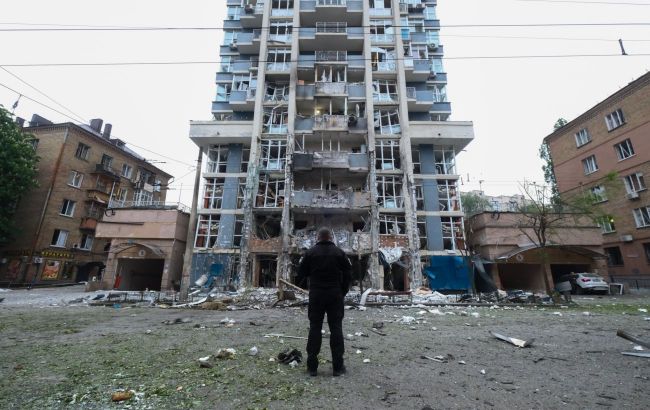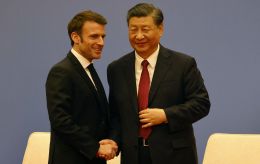Will Russia's massive attacks continue? What's ahead for Ukraine
 Photo: Russia has been carrying out massive air attacks on Ukraine for three nights in a row (Vitalii Nosach/RBC-Ukraine)
Photo: Russia has been carrying out massive air attacks on Ukraine for three nights in a row (Vitalii Nosach/RBC-Ukraine)
Russia has been launching a record number of drones and using missiles, striking Ukrainian territories from north to south. At the same time, the aggressor is ramping up arms production and pursuing several goals.
Key questions:
- Why has Russia suddenly escalated its attacks?
- What are the objectives of Russia's massive strikes on Ukraine?
- How much longer can Russia keep attacking, and what resources does it have?
- Are Russian drones really controlled through Telegram, and will that complicate interception?
For three consecutive nights, Russian forces have been massively attacking Ukraine with missiles and strike drones. Just today, the enemy deployed a record number of UAVs — 355 units, as well as launching 9 missiles. In the previous two days, there were 367 and 264 UAVs and missiles, respectively.
Under attack from the aggressor once again was Kyiv, and last night the geography of strikes stretched from the Chernihiv region to the Khmelnytskyi region and from the Kharkiv region to the Odesa region.
US President Donald Trump, after a series of Russian strikes on Ukraine, stated that Russian leader Vladimir Putin "has gone absolutely crazy" and warned that if he tries to seize all of Ukraine, it would "lead to the downfall of Russia."
Ukrainian President Volodymyr Zelenskyy, meanwhile, noted that with these strikes, Putin is demonstrating how much he disrespects the world, which spends more effort on dialogue with him than on pressure.
"Only a sense of total impunity can allow Russia to carry out such strikes and even constantly increase the scale. There is no significant military sense in this, but there is a significant political sense," Zelenskyy explained.
Some Ukrainian officials and Western analysts, as reported by the Financial Times, warn that Moscow may be preparing a new large-scale air campaign against Ukraine, possibly tied to a new ground offensive.
RBC-Ukraine spoke with a member of the Ukrainian Territorial Defense Forces and military expert Oleksandr Musiienko about the enemy's goals in massively attacking peaceful Ukrainian cities and what strike capabilities the aggressor currently has.
What is the objective of Russia's massive strikes on Ukraine?
As the interlocutor stated in a comment to RBC-Ukraine, the objective is primarily terrorism, and in any terrorism, there are corresponding goals:
- The first - is an attempt to demoralize the civilian population.
- The second - an attempt to intimidate.
- The third - a method of pressure.
- The fourth - stems from the fact that Russia cannot achieve its goals and results on the battlefield by military means.
"That is, to break Ukrainian resistance and, for example, to occupy Zaporizhzhia and Kherson - not to mention the fantasies Dmitry Medvedev keeps publishing. So they are trying to compensate for this with air strikes," Musiienko notes.
What capabilities does enemy have for drone attacks?
The expert agrees that indeed the enemy is increasing its capacity to produce Shahed drones and others used more for reconnaissance or combat operations. This includes Orlan, Zala, and Supercam drones.
"Indeed, the enemy's capacities have somewhat increased, but this was also anticipated. Whereas before the number of Shahed drone launches could range from 50–80 units per day, we now see they're reaching at least 150–200 drones per day, Musiienko says.
According to his assessment, with production ramping up, Russia can effectively carry out massive drone attacks on Ukraine three to four times a week at a rate of 150–200 drones.
"There's potential for further increase. However, Ukraine is not just observing. Every enemy strike is met with a response. Particularly, we are targeting military production facilities, including the Shahed production in Yelabuga (Tatarstan). That's one of the most effective ways to counter this," the Ukrainian military emphasizes.
What about the enemy’s missile capabilities?
As for missiles, the expert says the situation has not changed significantly. Russia can conduct 3–4, maximum 5, massive attacks per month.
"But this figure varies, depending on different factors. I would say that Russia has increased two components of its production - the sea-launched cruise missiles Kalibr and the Iskander-M ballistic missiles," the Ukrainian expert explains.
Musiienko notes that the aggressor uses Iskanders selectively - the maximum volley they allow themselves in a single day may be from 10 to 15 units.
Russia may have up to 500 ballistic missiles in reserve, according to The Economist.
"As for Kalibrs, based on their capabilities, they (Russians - ed.) can launch about 30 units. Let's just say, there's no significant growth in missile strike capabilities compared to before, but with Shaheds - there is," the Ukrainian military adds.
Is Russia producing missiles and drones faster than it can use them?
Journalists from the Financial Times also emphasize that Russia is now producing missiles and drones many times faster than it's deploying them.
According to Musiienko, Russia is producing Kalibr missiles and ballistic missiles more quickly. But they are not using them now at higher rates than before.
"That is, stockpiling can continue, but we must understand that technical capacities for launching these missiles are more limited compared to the number of missiles. They can build up stocks, but launching them simultaneously - that's where problems arise," the Ukrainian expert explains.
The invaders also have problems with strategic aviation - in particular, Tu-95 and Tu-160 aircraft are breaking down and their numbers are decreasing. Similarly, there are issues with the ability to launch Kalibrs and Iskanders.
Do Russian forces control Shahed UAVs through Telegram bots?
As The Economist writes, Ukrainian engineers in a Kyiv lab studying downed Russian drones recently found a note inside a Shahed stating that these drones are controlled in part through Telegram bots - which send operators real-time flight data and video.
Moreover, engineers discovered that new models of Russian drones are immune to electronic warfare. This is because they do not rely on GPS, instead being guided by artificial intelligence and using Ukrainian mobile networks.
However, Head of the Center for Countering Disinformation, Andriy Kovalenko, stated that there's nothing sensational about this. According to him, some Shahed drones have been operated this way since last year, with cameras installed and remote control used. Also, Kovalenko asserts that Shahed UAVs currently do not have artificial intelligence, although the enemy does have another strike drone with AI.
When asked whether this method of operating kamikaze drones could mean Ukraine's air defense will have a harder time countering such targets, expert Musiienko responded in the negative.
"No. We will continue to destroy Shahed drones. It's just that any change in the enemy's positions and parameters, its programs, requires additional time for us to study and develop a countermeasure. We already have countermeasures against mobile communication towers and more. I think, regarding these surveillance tools and Telegram bots, countermeasures will be developed as well," Musiienko concluded.
So, while the international community is making diplomatic efforts, trying to push Moscow toward at least a temporary ceasefire, Russia is showing the exact opposite intentions - sharply increasing air strikes on Ukrainian territory.
These strikes are happening amid negotiations, including increased efforts by the US and Europe to reach a settlement in the Russian-Ukrainian war.
In reality, Moscow is publicly demonstrating its unwillingness to compromise, instead trying to achieve its goals by force, cynically striking critical infrastructure and Ukrainian residential buildings.
Thus, Moscow is not only ignoring diplomacy but also sending a clear signal to the West that it does not want any ceasefire unless its terms are met.
Kyiv, meanwhile, is calling on the international community to respond more forcefully to the Kremlin's actions and hit back with sanctions against Russians. However, as political analyst Volodymyr Fesenko told RBC-Ukraine, instead of "hellish sanctions against Russia," we are facing a "hellish summer." Putin's goal is to break us morally and psychologically. So we must prepare not for the end of the war, but for its escalation.
Sources: materials from The Economist, Financial Times, data from the Ukrainian Air Force, statements from Ukrainian and US Presidents Volodymyr Zelenskyy and Donald Trump, and an exclusive commentary from a member of the Ukrainian Territorial Defense Forces and military expert Oleksandr Musiienko.

